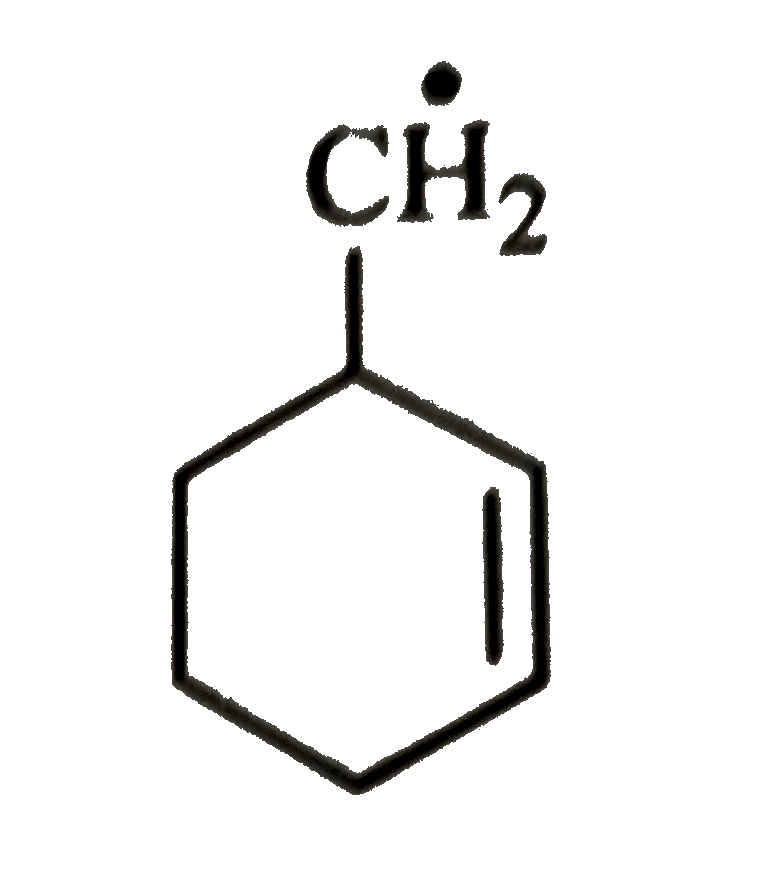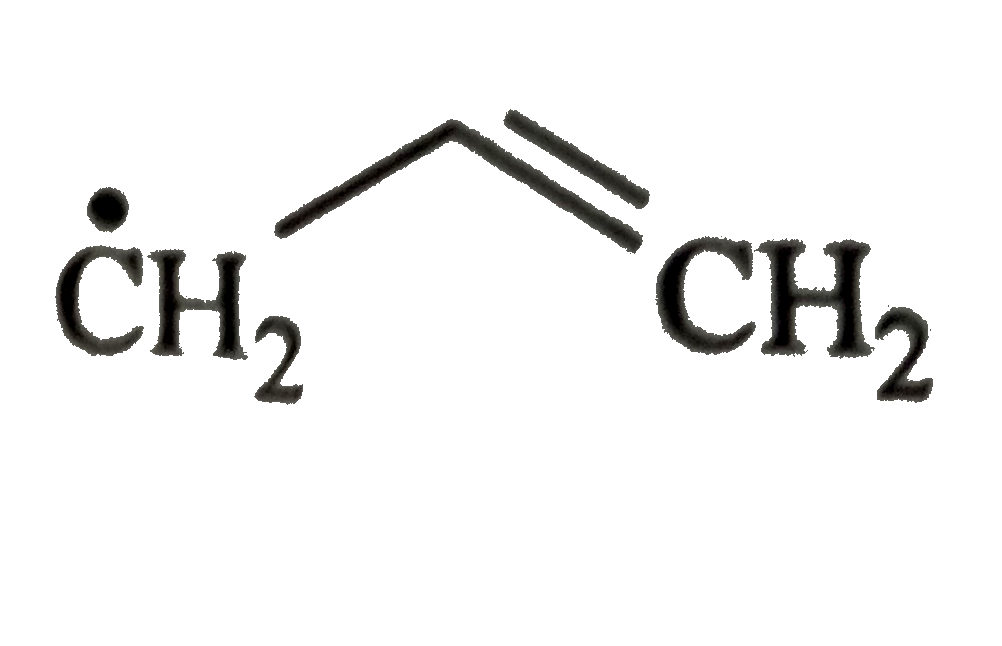The free radical which is most stable is
CH2=CH−.CH2

(H3C)3C⋅
⋅C2H5
To determine which free radical is the most stable among the given options, we can analyze the stability of each radical based on the concepts of resonance and inductive effects. Here’s a step-by-step solution:
1. Understanding Free Radicals: Free radicals are species with an unpaired electron. Stability is influenced by the ability of surrounding atoms or groups to donate electron density to the radical.
2. Analyzing the Options:
- Option 1: CH2=CH-CH2• (Allyl Radical):
- This radical can participate in resonance. The unpaired electron can be delocalized over the double bond, which increases stability.
- Option 2: Benzyl Radical (C6H5-CH2•):
- This radical is also capable of resonance. The unpaired electron can be delocalized into the aromatic ring, providing significant stabilization due to the resonance structures formed.
- Option 3: Tertiary Radical (C(CH3)3•):
- This radical has three methyl groups attached to the carbon bearing the radical. The methyl groups provide an inductive effect (+I), donating electron density and stabilizing the radical. However, it lacks resonance stabilization.
- Option 4: Ethyl Radical (CH3-CH2•):
- This radical has only one methyl group providing some inductive stabilization, but it is the least stable among the options due to the absence of resonance.
3. Comparing Stability:
- Resonance stabilization is generally more effective than inductive stabilization.
- Between the allyl radical (Option 1) and the benzyl radical (Option 2), the benzyl radical has more resonance structures available due to the aromatic ring, making it more stable than the allyl radical.
4. Conclusion:
- The benzyl radical (Option 2) is the most stable free radical among the options provided due to its extensive resonance stabilization.
Final Answer:
The free radical which is most stable is the Benzyl Radical (C6H5-CH2•).
- Option 1: CH2=CH-CH2• (Allyl Radical):
- This radical can participate in resonance. The unpaired electron can be delocalized over the double bond, which increases stability.
- Option 2: Benzyl Radical (C6H5-CH2•):
- This radical is also capable of resonance. The unpaired electron can be delocalized into the aromatic ring, providing significant stabilization due to the resonance structures formed.
- This radical has three methyl groups attached to the carbon bearing the radical. The methyl groups provide an inductive effect (+I), donating electron density and stabilizing the radical. However, it lacks resonance stabilization.
- This radical has only one methyl group providing some inductive stabilization, but it is the least stable among the options due to the absence of resonance.
- Resonance stabilization is generally more effective than inductive stabilization.
- Between the allyl radical (Option 1) and the benzyl radical (Option 2), the benzyl radical has more resonance structures available due to the aromatic ring, making it more stable than the allyl radical.
- The benzyl radical (Option 2) is the most stable free radical among the options provided due to its extensive resonance stabilization.
The free radical which is most stable is the Benzyl Radical (C6H5-CH2•).
Topper's Solved these Questions
- ORGANIC CHEMISTRY : SOME BASIC PRINCIPLES AND TECHNIQUES BOOK - AAKASH INSTITUTECHAPTER - ORGANIC CHEMISTRY : SOME BASIC PRINCIPLES AND TECHNIQUES EXERCISE - Assignment(SECTION-A)
60 Videos
- ORGANIC CHEMISTRY : SOME BASIC PRINCIPLES AND TECHNIQUES BOOK - AAKASH INSTITUTECHAPTER - ORGANIC CHEMISTRY : SOME BASIC PRINCIPLES AND TECHNIQUES EXERCISE - Assignment(SECTION B)
3 Videos
- ORGANIC CHEMISTRY : SOME BASIC PRINCIPLES AND TECHNIQUES BOOK - AAKASH INSTITUTECHAPTER - ORGANIC CHEMISTRY : SOME BASIC PRINCIPLES AND TECHNIQUES EXERCISE - Try Yourself
23 Videos
- MOCK_TEST_20BOOK - AAKASH INSTITUTECHAPTER - MOCK_TEST_20EXERCISE - EXAMPLE
28 Videos
- ORGANIC CHEMISTRY: SOME BASIC PRINCIPLE AND TECHNIQUESBOOK - AAKASH INSTITUTECHAPTER - ORGANIC CHEMISTRY: SOME BASIC PRINCIPLE AND TECHNIQUESEXERCISE - TRY YOURSELF
28 Videos
Similar Questions
Knowledge Check
Which of the free radicals is most stable?
ACH3.CH2BCH2=CH−CH2C(CH3)2CHD(CH3)3CWhich is most stable radical ?
ACH3BCH2=CH−CH2CCH3−CH2D
Which among the following free radicals is most stable
A B
B CC.H3D
CC.H3D
Which of the following free radicals is the most stable?
View SolutionThe most stable free radical which can be isolated is
View SolutionWhich free radical is the least stable ?
View Solution(A) Allyl free radical is more stable than simple alkyl free radical.
(R) The allyl free radical is stabilized by resonance.
View Solution(A) Allyl free radical is more stable than simple alkyl free radical.
(R) The allyl free radical is stabilized by resonance.
View Solution
